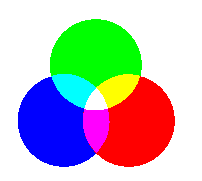 Mike Lights, Inc.
Mike Lights, Inc. 
 Mike Lights, Inc.
Mike Lights, Inc. 
 This is additive
color mixing of light. On the other hand, the mixing of filters rather
than resultant light, works in a subtractive way. Mixing
assorted filters in front of one beam will move its light towards black.
White light is a mixture of all colors in the spectrum.
By passing this white light through a filter, we are not coloring the light,
but we are filtering out the other colors. White light can be split
into three primary colors: red, blue and green. They can therefore
be mixed together to make white light. A deep red filter will remove
everything except the red part of the spectrum. Mix two primary colors
and you will get a third color, mix other two of those primaries and you
will get another color. Mix those two resultants and you once again
get a different color. From here you´ll
find information on how to mix Lee color filters to get white light.
This is additive
color mixing of light. On the other hand, the mixing of filters rather
than resultant light, works in a subtractive way. Mixing
assorted filters in front of one beam will move its light towards black.
White light is a mixture of all colors in the spectrum.
By passing this white light through a filter, we are not coloring the light,
but we are filtering out the other colors. White light can be split
into three primary colors: red, blue and green. They can therefore
be mixed together to make white light. A deep red filter will remove
everything except the red part of the spectrum. Mix two primary colors
and you will get a third color, mix other two of those primaries and you
will get another color. Mix those two resultants and you once again
get a different color. From here you´ll
find information on how to mix Lee color filters to get white light.